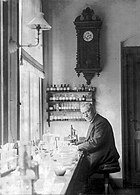Portal:Viruses/Selected miscellany/3
The history of virology is usually considered to begin in the late 19th century, when the first evidence for the existence of viruses came from experiments using filters with pores small enough to retain bacteria. Dmitry Ivanovsky showed in 1892 that sap from a diseased tobacco plant remained infectious despite having been filtered; this agent, later known as tobacco mosaic virus, was the first virus to be demonstrated. In 1898, Friedrich Loeffler and Paul Frosch showed that foot-and-mouth, an animal disease, was caused by a filterable agent. That year, Martinus Beijerinck (pictured) called the filtered infectious substance a "virus" – often considered to mark the beginning of virology.
Bacteriophages, viruses that infect bacteria, were characterised by Frederick Twort and Félix d'Herelle in the early 20th century. In 1926, Thomas Milton Rivers defined viruses as obligate parasites. Viruses were demonstrated to be particles, rather than a fluid, by Wendell Meredith Stanley, and the invention of the electron microscope in 1931 allowed them to be visualised.

